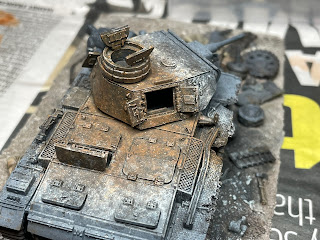I finished off my diorama/terrain piece of a burnt out Panzer III this weekend. Here are some more in-progress shots illustrating how I got to finished article. In the last blog, I had got to the stage where I had finished the base, undercoated and then highlighted the tank using my airbrush and then hand-painted the base colours onto the tracks.
In my last post, I had been debating over which of two techniques to follow; in the end I made up my own technique, which combined a bit of both.
After applying the base colours, the next stage was painting the burnt effect onto the tank's rear deck and turret, representing an engine fire. I used two colours for this: Vallejo Model Color USA Olive Drab 70.889 for the first coat and Black 70.950 for the top coat.
The next coat of paint was Vallejo Game Color Parasite Brown 72.042, which is actually not very brown, much more orange, but a really good proxy for oxidised metal. This was dabbed on using a piece of sponge.
The final base colour, which was dabbed on with a piece of sponge, was Vallejo Model Air Sand (Ivory) 71.075. This was added around the edge of the burnt area.
The tarpaulin looks a bit translucent in this photo because it is still wet with water and glue.
The last stage involved using MIG pigment powders and a fixing agent over the top of the base paint layers. The pigment colours were Old Rust (P230), Light Rust (P024) and Light Dust (P027)
Anyway, I think I am calling this finished now, other than to apply some flock and static grass to the base.
If you have any questions about any part of this project, post a question in the Comments section below.
My next (or next but one) project will be a damaged horse-drawn supply wagon with the dead horses and several casualty figures.












































